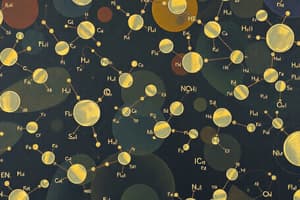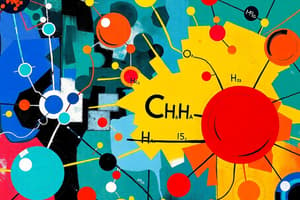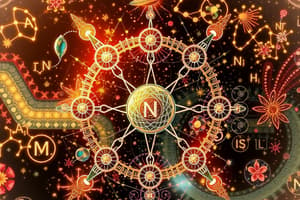Podcast
Questions and Answers
What is the chemical formula for carbon dioxide?
What is the chemical formula for carbon dioxide?
CO₂
Which of the following is the correct chemical formula for methane?
Which of the following is the correct chemical formula for methane?
- CH₄ (correct)
- C₂H₄
- CH₂
- CO₂
The chemical formula of a compound always represents the actual arrangement of atoms in space.
The chemical formula of a compound always represents the actual arrangement of atoms in space.
False (B)
The ______________ of mass states that in any chemical reaction, the total mass of the reactants is equal to the total mass of the products.
The ______________ of mass states that in any chemical reaction, the total mass of the reactants is equal to the total mass of the products.
Match the following chemical formulae with their respective compound names:
Match the following chemical formulae with their respective compound names:
What is the valency of nitrogen in ammonia (NH₃)?
What is the valency of nitrogen in ammonia (NH₃)?
Which of the following laws explains why the ratio of elements in a given compound is always fixed?
Which of the following laws explains why the ratio of elements in a given compound is always fixed?
The chemical formula for sulfuric acid is ______________.
The chemical formula for sulfuric acid is ______________.
Flashcards
Atoms
Atoms
Fundamental building blocks of matter.
Molecules
Molecules
Formed when two or more atoms chemically combine.
Elements
Elements
Substances made of only one type of atom.
Compounds
Compounds
Signup and view all the flashcards
Chemical Formulae
Chemical Formulae
Signup and view all the flashcards
Law of Conservation of Mass
Law of Conservation of Mass
Signup and view all the flashcards
Valency
Valency
Signup and view all the flashcards
Ionic vs. Covalent Compounds
Ionic vs. Covalent Compounds
Signup and view all the flashcards
Study Notes
Atoms and Molecules
- Atoms are the fundamental building blocks of matter.
- Molecules are formed when two or more atoms chemically combine.
- Molecules can be elements or compounds.
- Elements are composed of only one type of atom.
- Compounds are composed of two or more different types of atoms chemically bonded together.
Formulae
- Chemical formulae represent the composition of compounds using symbols and subscripts.
- Symbols represent elements.
- Subscripts indicate the number of atoms of each element in the compound.
- For example, water, H₂O, indicates two hydrogen atoms and one oxygen atom in a water molecule.
- Examples:
- Hydrogen: H₂
- Oxygen: O₂
- Water: H₂O
- Carbon dioxide: CO₂
- Methane: CH₄
- Sodium chloride (table salt): NaCl
- The formula of a compound does not necessarily represent the actual arrangement of atoms in space.
Names of Compounds
- The naming of compounds follows established rules, depending on the type (ionic or covalent compounds), which provide concise and systematic identification across various chemical compounds.
- Ionic compounds generally involve a metal and a non-metal.
- Covalent compounds arise when non-metals combine.
- For example, NaCl is sodium chloride, CO₂ is carbon dioxide, and H₂SO₄ is sulfuric acid. Following the rules, these names are specific to each compound, helping avoid ambiguity.
Laws of Chemical Combinations
- Law of Conservation of Mass: In any chemical reaction, the total mass of the reactants is equal to the total mass of the products.
- This implies that matter is neither created nor destroyed during a chemical reaction, only rearranged.
- Law of Definite Proportions: A given compound always contains the same elements in the same fixed proportion by mass.
- For a given compound, the ratio of the mass of one element to the mass of another element is constant.
- Law of Multiple Proportions: If two elements can combine to form more than one compound, the masses of one element that combine with a fixed mass of the other element are in a ratio of small whole numbers.
- This law highlights how the ratio of combining masses of one element to another element (in different chemical compounds) is always a ratio of small whole numbers.
Valency
- Valency is the combining capacity of an element.
- It represents the number of electrons an atom can gain, lose, or share to form a chemical bond.
- It can be determined from the chemical formula of the compound.
- Different elements display different valencies.
- For many ionic compounds, the valencies of elements can be determined based on their position in the periodic table.
- Oxidation states describe the hypothetical charge that an atom would have if the bonds were fully ionic.
- The sum of oxidation states in each compound is zero.
- For compounds containing transition metals, valencies may not always be apparent from the periodic table alone. More complex rules for determination may be needed.
- Valency influences the type of bonds formed (ionic or covalent) and how many atoms are needed to combine to form a neutral molecule or compound.
Studying That Suits You
Use AI to generate personalized quizzes and flashcards to suit your learning preferences.




